提示:文章写完后,目录可以自动生成,如何生成可参考右边的帮助文档
AQS原理
概述
全称是AbstractQueuedStnchronizer,是阻塞式锁和相关同步器工具的框架
特点:
1、用state属性来表示锁的状态(分独占模式和共享模式),子类需要定义如何维护这个状态,控制如何获取锁和释放锁
- getstate:获取state状态
- setState:设置state状态
- compareAndSetState:乐观锁机制设置state状态
2、提供了FIFO的等待队列,类似Monitor的EntryList
3、条件变量来实现等待、唤醒机制、支持多个条件变量。类似于Monitor的WaitSet
子类主要实现这样一些方法(默认抛出UnsupportedOperationException)
- tryAcquire
- tryRelease
- tryAcquireShared
- tryReleasedShared
- isHeldExclusively
获取锁的姿势
//如果获取锁失败
if(!tryAcquire(arg){
//入队,可以选择阻塞当前队列 park unpark
}
释放锁的姿势
//如果获取锁失败
if(tryRelease(arg){
//让阻塞线程恢复运行
}
AQS其实定义的是实现锁的原理,下面是我自己写的一个基于装饰者模式不可重入锁的实现示例
/自定义锁,不可重入锁
class Mylock implements Lock {
//独占锁
class Mysync extends AbstractQueuedSynchronizer {
@Override
protected boolean tryAcquire(int arg) {
if (compareAndSetState(0, 1)) {
//加上了锁,设置owner为当前线程
setExclusiveOwnerThread(Thread.currentThread());
return true;
}
return false;
}
@Override
protected boolean tryRelease(int arg) {
setExclusiveOwnerThread(null);
// state是 volatile修饰的,这里最好把setState写在setExclusiveOwnerThread后面
setState(0);
//写屏障可以保证Owner的修改也会被同步到主存,对其他线程可见
return true;
}
//是否持有独占锁
@Override
protected boolean isHeldExclusively() {
return getState() == 1;
}
public Condition newCondition() {
return new ConditionObject();
}
}
private Mysync sync = new Mysync();
//加锁,不成功进入队列等待
@Override
public void lock() {
sync.acquire(1);
}
//加锁,可打断
@Override
public void lockInterruptibly() throws InterruptedException {
sync.acquireInterruptibly(1);
}
//尝试加锁
@Override
public boolean tryLock() {
return sync.tryAcquire(1);
}
//尝试加锁 超时
@Override
public boolean tryLock(long time, TimeUnit unit) throws InterruptedException {
return sync.tryAcquireNanos(1, unit.toNanos(time));
}
//释放锁
@Override
public void unlock() {
sync.release(1);
}
// 条件变量
@Override
public Condition newCondition() {
return sync.newCondition();
}
}
测试一下
@Slf4j(topic = "c.TestAqs")
public class TestAqs {
public static void main(String[] args) {
Mylock lock = new Mylock();
new Thread(()->{
lock.lock();
try {
log.debug("locking");
Thread.sleep(1000);
} catch (InterruptedException e) {
e.printStackTrace();
} finally {
log.debug("unlocking");
lock.unlock();
}
},"t1").start();
new Thread(()->{
lock.lock();
try {
log.debug("locking");
} finally {
log.debug("unlocking");
lock.unlock();
}
},"t2").start();
}
}
19:01:14.944 [t1] DEBUG c.TestAqs - locking
19:01:15.967 [t1] DEBUG c.TestAqs - unlocking
19:01:15.968 [t2] DEBUG c.TestAqs - locking
19:01:15.968 [t2] DEBUG c.TestAqs - unlocking
ReentrantLock 原理
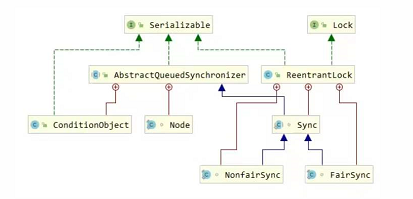
由类图可以看出,ReentrantLock 继承自Lock,也提供了以sync的同步器,这个同步器有两种模式,一个是公平模式,一个是非公平模式,同时这个同步器也是基于AQS原理
加锁流程
先从构造器看,默认为非公平锁实现
public ReentrantLock() {
sync = new NonfairSync();
}
NonfairSync继承自AQS


也就是说同步器有两种实现,一种是公平的,一种是非公平的,公平的满足先进先出(FIFO)
加锁成功
首先看下加锁 lock()源码
abstract void lock();
它有两种实现,一种是公平的,一种是非公平的

1、非公平
final void lock() {
//先尝试用compareAndSetState修改state,如果修改成功就是加锁成功
if (compareAndSetState(0, 1))
//加锁成功,把owner线程(exclusiveOwnerThread)改为当前线程
setExclusiveOwnerThread(Thread.currentThread());
else
acquire(1);//如果出现竞争,比如state已经被修改为1,当前线程加锁失败,执行此方法
}
代码执行流程:
- 如果CAS修改state的值为1成功,就意味着加锁成,然后修改exclusiveOwnerThread为当前加锁的线程
- 如果执行失败执行acquire(int arg)方法
如果state是0的话,,没有其他线程与当前线程竞争,那么势必加锁成功
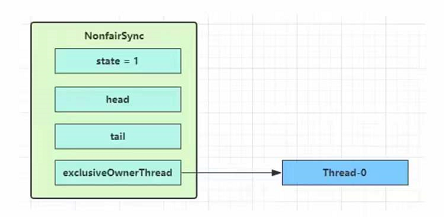
2、公平
final void lock() {
acquire(1);
}
代码执行流程: 直接执行 acquire(1)方法
3、acquire(int arg)
有以上公平锁和非公平锁的加锁可以看出,非公锁加锁失败后执行acquire方法,公平锁直接执行acquire,acquire方法是独占式的获取锁的流程,我们就对这个方法进行分析
public final void acquire(int arg) {
if (!tryAcquire(arg) &&
acquireQueued(addWaiter(Node.EXCLUSIVE), arg))
selfInterrupt();
}
代码执行流程:
首先执行tryAcquire(int arg) 方法
protected boolean tryAcquire(int arg) {
throw new UnsupportedOperationException();
}
(1)tryAcquire(int arg) 非公平锁的实现
protected final boolean tryAcquire(int acquires) {
return nonfairTryAcquire(acquires);
}
final boolean nonfairTryAcquire(int acquires) {
// 获取当前线程对象current
final Thread current = Thread.currentThread();
// 获取state的值
int c = getState();
// 很多人可能会疑惑,之前非公平的加锁lock() 不是加锁失败了嘛,怎么这里还判断,这是因为
// 在从lock执行到nonfairTryAcquire方法时,可能有加锁线程已经释放了锁
if (c == 0) {
// 如果没线程没有加锁。当前线程直接CAS更改state,CAS操作成功意味着加锁成功
// 需要修改exclusiveOwnerThread为当前线程,并返回true,意味着加锁成功
if (compareAndSetState(0, acquires))
setExclusiveOwnerThread(current);
return true;
}
}
else if (current == getExclusiveOwnerThread()) {
// 如果已经有线程加锁,就判断加锁的这个线程是不是当前线程,如果是就把state+1,
// 意味着锁重入行为发生,并返回ture
int nextc = c + acquires;
if (nextc < 0) // overflow
throw new Error("Maximum lock count exceeded");
setState(nextc);
return true;
}
return false;
}
(2)tryAcquire(int arg) 公平锁的实现
protected final boolean tryAcquire(int acquires) {
// 同样获取当前线程对象current
final Thread current = Thread.currentThread();
// 获取state的值
int c = getState();
// 判断是否加锁(不再解释)
if (c == 0) {
// 不同的是这一点,公平锁在加锁前会通过hasQueuedPredecessors()方法,判断同步队列中是不是有其他节点,
// 这是因为公平锁要满足先进先出的特性,要让其他等待时间长的先加锁
if (!hasQueuedPredecessors() &&
compareAndSetState(0, acquires)) {
setExclusiveOwnerThread(current);
return true;
}
}
//同样下面锁重入的逻辑,不再解释
else if (current == getExclusiveOwnerThread()) {
int nextc = c + acquires;
if (nextc < 0)
throw new Error("Maximum lock count exceeded");
setState(nextc);
return true;
}
return false;
}
}
小结:分析了非公平锁和公平锁的加锁流程,可以得知,
- 非公平锁在加锁的时候,不需要判断同步队列中是否有其他节点,只要CAS操作更改state成功了,就意味着当前线程获取到了锁
- 公平锁在加锁的时候,需要判断同步队列中是否有其他节点,也就是先让head节点的后继结点先加锁,以满足先进先出的特性
- 所谓的锁重入,也不过是判断是否是当前线程,如果是当前线程就state+1,实现加锁的重入操作
值得说的是,个人建议,如果没有特殊需求,请用非公平锁,虽然非公平锁可能会发生线程·饥饿,但是非公平锁会带来更少的上下文切换,吞吐量更好
加锁失败
我们之前分析的加锁,都是加锁成功的情况,如果加锁失败呢
还是下面这块代码
static final Node EXCLUSIVE = null;
public final void acquire(int arg) {
if (!tryAcquire(arg) &&
acquireQueued(addWaiter(Node.EXCLUSIVE), arg))
selfInterrupt();
}
(1) 首先执行addWaiter,构建同步队列
private Node addWaiter(Node mode) {
//以当前线程创建节点node
Node node = new Node(Thread.currentThread(), mode);
// Try the fast path of enq; backup to full enq on failure
//如果是第一次添加节点,tail是null执行enq方法
Node pred = tail;
if (pred != null) {
// 把node节点加入队列尾部
node.prev = pred;
if (compareAndSetTail(pred, node)) {
pred.next = node;
return node;
}
}
enq(node);
return node;
}
private Node enq(final Node node) {
for (;;) {
Node t = tail;
if (t == null) { // Must initialize
if (compareAndSetHead(new Node()))
tail = head;
} else {
node.prev = t;
if (compareAndSetTail(t, node)) {
t.next = node;
return t;
}
}
}
}
上面enq就是一个死循环形成同步队列的过程,可以自己画图一步一步分析,执行完enq,就是下图这么一个队列
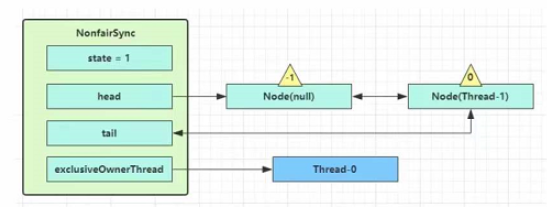
(2) 然后执行acquireQueued
final boolean acquireQueued(final Node node, int arg) {
boolean failed = true;
try {
boolean interrupted = false;
for (;;) {
final Node p = node.predecessor(); //获取当前节点的前驱节点
if (p == head && tryAcquire(arg)) {//如果前去节点是head,就尝试获取锁
setHead(node);
p.next = null; // help GC
failed = false;
return interrupted;
}
// shouldParkAfterFailedAcquire判断获取锁失败的线程是否应该park住,
// 第一次执行时,当前节点的前驱节点waitStatus是默认值0(刚加入同步队列的都是0),
// 根据下面shouldParkAfterFailedAcquire源码可以得知,该方法会把waitStatus置为-1,并返回fasle
//因此第一循环parkAndCheckInterrupt不执行
// 第二次执行到这shouldParkAfterFailedAcquire方法时
// 根据源码,可知shouldParkAfterFailedAcquire会返回true
// 因此执行parkAndCheckInterrupt方法,park住当前线程,不让它占用CPU了
if (shouldParkAfterFailedAcquire(p, node) &&
parkAndCheckInterrupt())
interrupted = true;
}
} finally {
if (failed)
cancelAcquire(node);
}
}
static final int SIGNAL = -1;
private static boolean shouldParkAfterFailedAcquire(Node pred, Node node) {
int ws = pred.waitStatus;
if (ws == Node.SIGNAL)
/*
* This node has already set status asking a release
* to signal it, so it can safely park.
*/
return true;
if (ws > 0) {
/*
* Predecessor was cancelled. Skip over predecessors and
* indicate retry.
*/
do {
node.prev = pred = pred.prev;
} while (pred.waitStatus > 0);
pred.next = node;
} else {
/*
* waitStatus must be 0 or PROPAGATE. Indicate that we
* need a signal, but don't park yet. Caller will need to
* retry to make sure it cannot acquire before parking.
*/
compareAndSetWaitStatus(pred, ws, Node.SIGNAL);
}
return false;
}
private final boolean parkAndCheckInterrupt() {
LockSupport.park(this);
return Thread.interrupted();
}
最终第二个线程如果加锁失败就会形成这样:
第一个Node称为Dummy(哑元)或者烧饼,用来占位,不关联线程

小结:加锁失败的线程会被包装成Node节点,构成一个同步队列,线程刚开始会自旋在acquireQueued方法中,但是不是一直在执行死循环,而是循环两次后,被park住,第一循环是修改前驱节点的waitStatus为-1,第二次循环,判断出前驱节点的waitStatus为-1后,会park住当前线程
解锁流程
如果有多个线程加锁失败就会变成这个样子:

那怎么解锁呢?看下unlock()源码
public void unlock() {
sync.release(1);
}
解锁最终是执行同步器的release(int arg) 方法,那就分析release(int arg)
public final boolean release(int arg) {
if (tryRelease(arg)) {
Node h = head;
if (h != null && h.waitStatus != 0)
unparkSuccessor(h);
return true;
}
return false;
}
首先执行tryRelease(int arg)
protected boolean tryRelease(int arg) {
throw new UnsupportedOperationException();
}
找到ReentrantLock 的实现
protected final boolean tryRelease(int releases) {
int c = getState() - releases;//获取当前的state值并减1
//getExclusiveOwnerThread是获取当前加锁的线程,(还记得之前exclusiveOwnerThread嘛) 如果解锁的不是解锁的线程,直接报错
if (Thread.currentThread() != getExclusiveOwnerThread())
throw new IllegalMonitorStateException();
boolean free = false;
if (c == 0) {//如果state为-1后为0了,就意味着解锁成功
free = true;
setExclusiveOwnerThread(null);
//修改exclusiveOwnerThread为null,当前没人占有锁
}
setState(c); //把state更新为c
return free;
}
上述代码的执行逻辑:先判断解锁的线程是不是锁拥有线程,如果不是就抛出异常,如果是,就判断state-1后,是不是为0,如果为0了,说明解锁成功,把锁的拥有者置为null。更新state的值为state-1
如果state-1不等于0.说明当前线程之前发生过重入,那么每次解锁state都减去1,直到state=0,解锁成功
再看release(int arg) ,如果解锁成就会执行if条件内的代码
public final boolean release(int arg) {
if (tryRelease(arg)) {
Node h = head; //获取头节点head,当前场景肯定不会为null呀,因为之前enq创建同步队列的时候,初始化了
//判断同步队列中是不是有阻塞的线程,如果有就执行unparkSuccessor唤醒线程
if (h != null && h.waitStatus != 0)
// 当前waitStatus 为-1,因为之前节点进入同步队列在自旋的时候,第一次自旋就是修改其前驱节点的waitStatus 为-1
unparkSuccessor(h);
return true;
}
return false;
}
private void unparkSuccessor(Node node) {
/*
* If status is negative (i.e., possibly needing signal) try
* to clear in anticipation of signalling. It is OK if this
* fails or if status is changed by waiting thread.
*/
int ws = node.waitStatus;
if (ws < 0)//把head节点的waitStatus 置为0
compareAndSetWaitStatus(node, ws, 0);
/*
* Thread to unpark is held in successor, which is normally
* just the next node. But if cancelled or apparently null,
* traverse backwards from tail to find the actual
* non-cancelled successor.
*/
Node s = node.next;//获取头节点的后继结点,本例肯定不为null呀,因为线程阻塞
if (s == null || s.waitStatus > 0) {
s = null;
for (Node t = tail; t != null && t != node; t = t.prev)
if (t.waitStatus <= 0)
s = t;
}
if (s != null)
//unpark 唤醒当前线程
LockSupport.unpark(s.thread);
}
小结:解锁的时候,先调用tryRelease方法释放锁,如果释放锁的线程不是当前锁拥有线程直接抛出异常,如果是,当state=0时,才意味着解锁成功,解锁成功后,就会唤醒同步队列中的head节点的后继结点,唤醒后的节点会重新竞争锁,那就会执行一遍加锁逻辑。如果竞争成功就获得锁,否则加到同步队列尾部

可重入原理
前面分析加锁解锁的时候,也分析了可重入了
总结下来就是
- 加锁时,如果锁已经被获取,且是当前线程获取的话,就实现锁重入,锁重入就是把state加1
- 解锁时,如果解锁的是当前获取锁的线程,就把state-1,如果state变为0,那就是解锁成功,如果state>1,说明之前重入了多次,只有等多次执行释放锁操作之后,如果state为0,就意味锁重入的解锁成功
打断原理
ReentrantLock,如果被打断有什么反应呢?我们直到被阻塞线程如果被打断,必然会抛出InterruptedException异常
不可打断的获取锁
当前线程如果在执行lock()方法时,如果获取失败,经过上面加锁的分析,我知道线程会在自旋中进行park,也就是阻塞,
final boolean acquireQueued(final Node node, int arg) {
boolean failed = true;
try {
boolean interrupted = false;
for (;;) {
final Node p = node.predecessor(); //获取当前节点的前驱节点
if (p == head && tryAcquire(arg)) {//如果前去节点是head,就尝试获取锁
setHead(node);
p.next = null; // help GC
failed = false;
return interrupted;
}
// shouldParkAfterFailedAcquire判断获取锁失败的线程是否应该park住,
// 第一次执行时,当前节点的前驱节点waitStatus是默认值0(刚加入同步队列的都是0),
// 根据下面shouldParkAfterFailedAcquire源码可以得知,该方法会把waitStatus置为-1,并返回fasle
//因此第一循环parkAndCheckInterrupt不执行
// 第二次执行到这shouldParkAfterFailedAcquire方法时
// 根据源码,可知shouldParkAfterFailedAcquire会返回true
// 因此执行parkAndCheckInterrupt方法,park住当前线程,不让它占用CPU了
if (shouldParkAfterFailedAcquire(p, node) &&
parkAndCheckInterrupt()) //打断后parkAndCheckInterrupt返回true
interrupted = true;
}
} finally {
if (failed)
cancelAcquire(node);
}
}
private final boolean parkAndCheckInterrupt() {
LockSupport.park(this); //线程阻塞在这
return Thread.interrupted();//如果被打断,返回打断标记true,另外interrupted还清除了打断标记,置为false
}
我们看出来,被打断的线程,只不过从阻塞状态又进行了一次自旋,尝试获取锁,如果失败,还是会继续park阻塞线程
可打断的获取锁
ReentrantLock还有一个可打断的方法lockInterruptibly(),我们重点关注怎么处理打断的
public void lockInterruptibly() throws InterruptedException {
sync.acquireInterruptibly(1);
}
public final void acquireInterruptibly(int arg)
throws InterruptedException {
if (Thread.interrupted())
throw new InterruptedException();//关键代码
if (!tryAcquire(arg))
doAcquireInterruptibly(arg);
}
private void doAcquireInterruptibly(int arg)
throws InterruptedException {
final Node node = addWaiter(Node.EXCLUSIVE);
boolean failed = true;
try {
for (;;) {
final Node p = node.predecessor();
if (p == head && tryAcquire(arg)) {
setHead(node);
p.next = null; // help GC
failed = false;
return;
}
if (shouldParkAfterFailedAcquire(p, node) &&
parkAndCheckInterrupt())
throw new InterruptedException();//关键代码
}
} finally {
if (failed)
cancelAcquire(node);
}
}
从源码中可以看出,如果线程被打断会直接抛出InterruptedException,同时也会修改打断标记。
总结
lock()不可打断的获取锁,如果获取锁失败的阻塞的线程被打断,不会抛出异常,而是进行一次自旋,尝试获取一次锁,如果获取不到被打断的线程还会继续阻塞
lockInterruptibly()是可以被打断的获取锁的方法,如果被打断,直接抛出InterruptedException异常,同时会修改打断标记为fasle
条件变量原理
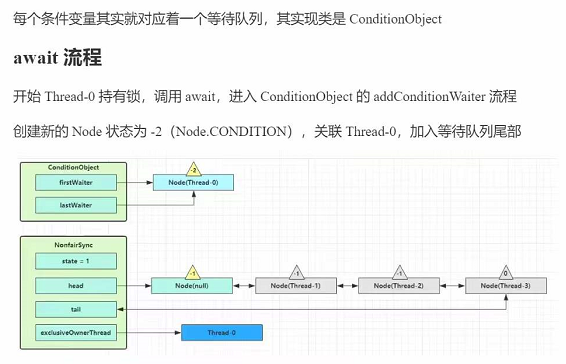

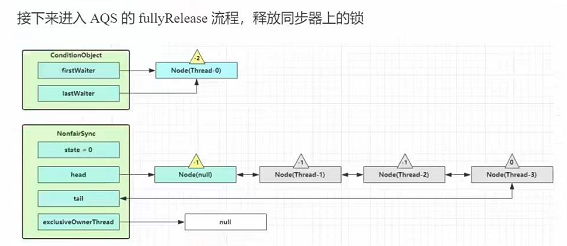
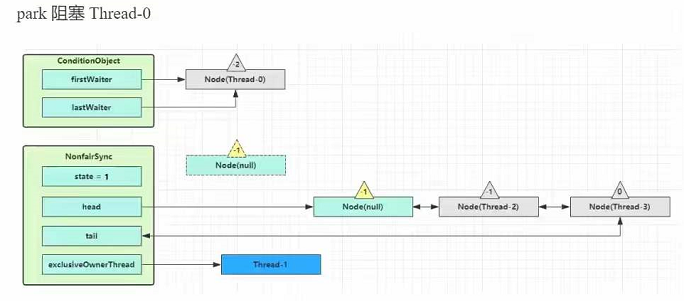
public final void await() throws InterruptedException {
if (Thread.interrupted())
throw new InterruptedException();
Node node = addConditionWaiter();
int savedState = fullyRelease(node);
int interruptMode = 0;
while (!isOnSyncQueue(node)) {
LockSupport.park(this);
if ((interruptMode = checkInterruptWhileWaiting(node)) != 0)
break;
}
if (acquireQueued(node, savedState) && interruptMode != THROW_IE)
interruptMode = REINTERRUPT;
if (node.nextWaiter != null) // clean up if cancelled
unlinkCancelledWaiters();
if (interruptMode != 0)
reportInterruptAfterWait(interruptMode);
}
signal流程
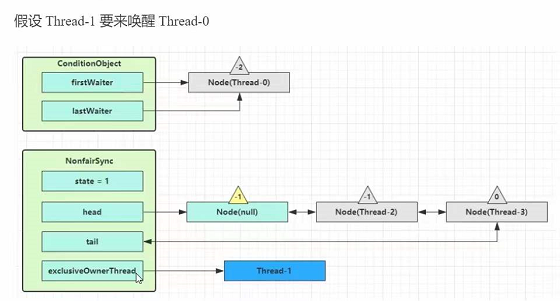
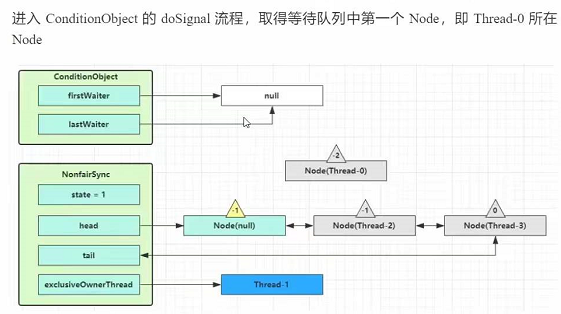
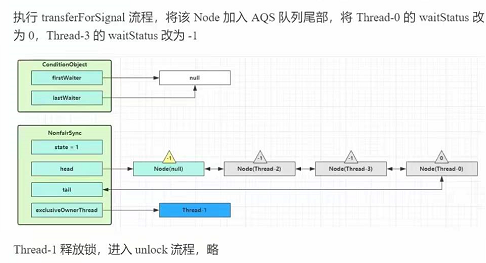
public final void signal() {
if (!isHeldExclusively())
throw new IllegalMonitorStateException();
Node first = firstWaiter;
if (first != null)
doSignal(first);
}
/**
* Removes and transfers nodes until hit non-cancelled one or
* null. Split out from signal in part to encourage compilers
* to inline the case of no waiters.
* @param first (non-null) the first node on condition queue
*/
private void doSignal(Node first) {
do {
if ( (firstWaiter = first.nextWaiter) == null)
lastWaiter = null;
first.nextWaiter = null;
} while (!transferForSignal(first) &&
(first = firstWaiter) != null);
}
final boolean transferForSignal(Node node) {
/*
* If cannot change waitStatus, the node has been cancelled.
*/
if (!compareAndSetWaitStatus(node, Node.CONDITION, 0))
return false;
/*
* Splice onto queue and try to set waitStatus of predecessor to
* indicate that thread is (probably) waiting. If cancelled or
* attempt to set waitStatus fails, wake up to resync (in which
* case the waitStatus can be transiently and harmlessly wrong).
*/
Node p = enq(node);
int ws = p.waitStatus;
if (ws > 0 || !compareAndSetWaitStatus(p, ws, Node.SIGNAL))
LockSupport.unpark(node.thread);
return true;
}
private Node enq(final Node node) {
for (;;) {
Node t = tail;
if (t == null) { // Must initialize
if (compareAndSetHead(new Node()))
tail = head;
} else {
node.prev = t;
if (compareAndSetTail(t, node)) {
t.next = node;
return t;
}
}
}
}






















 712
712











 被折叠的 条评论
为什么被折叠?
被折叠的 条评论
为什么被折叠?








